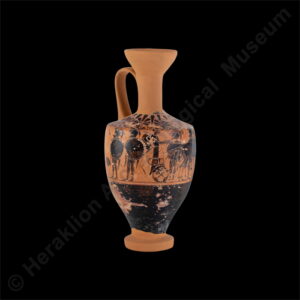
A vase-painting style of the Archaic and Classical periods. The decoration consists of scenes in which the figures are silhouetted in black alkali clay slip on the light glossy ground of the vase, with details rendered by incision and two colours of clay slip, white and purple. The strong contrast between the black figures and the light ground of the scenes is achieved by controlled firing in the kiln with three alternating phases: oxidising, reducing and oxidising again. The black-figure style was invented in Corinthian workshops in the early 7th c. BC, but was fully developed as a decorative technique by Athenian vase-painters, who adopted it around 630 BC and played a key role in its wide dissemination in the following century.